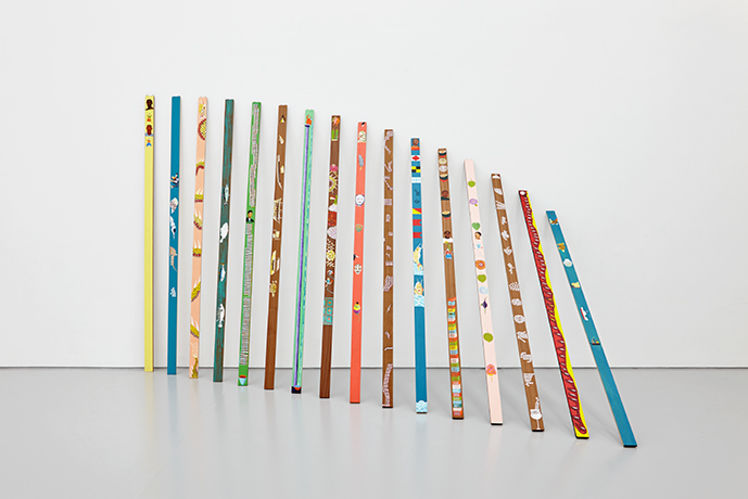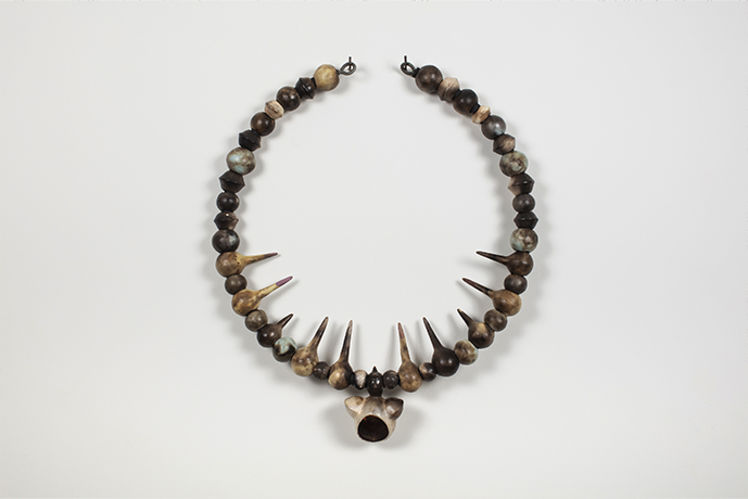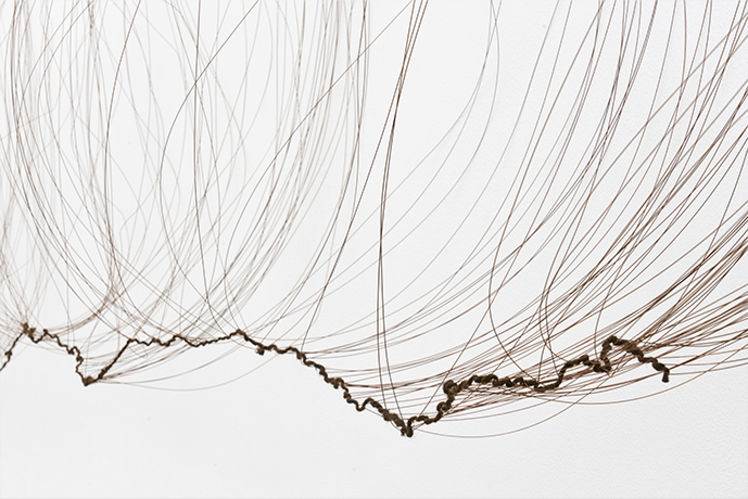SIGHTLINES on Peace, Power & Prestige: Metal Arts in Africa features large-scale sculptures, photography, weavings, metal work, and multi-media installations by contemporary makers. Meet the artists below:
AD—WO

Jen Wood and Emanuel Admassu of AD—WO.
AD—WO is an art and architecture practice based in New York City, and by extension, between Naarm/Melbourne and Addis Ababa. The practice examines how space is imaged and valued through art, design, and curatorial interventions. Founded in 2015 by Jen Wood and Emanuel Admassu, AD—WO has undertaken projects in Ethiopia, Tanzania, Germany, Italy, and the United States. Their work has been exhibited at La Biennale di Venezia (2023), Art Omi (2023), the Museum of Modern Art in New York (2021), Architekturmuseum der TU München (2018), and the Studio Museum in Harlem (2017). AD—WO’s work is in the permanent collections of the Art Institute of Chicago and the High Museum of Art (Atlanta).
Radcliffe Bailey

Photo by LaMont Hamilton.
Radcliffe Bailey (1968–2023) was a painter, sculptor, and mixed media artist who utilized the layering of imagery, culturally resonant materials, and text to explore themes of ancestry, race, migration, and collective memory. His work often incorporated found materials and objects from his past into textured compositions, including traditional African sculpture, tintypes of his family members, ships, train tracks, and Georgia red clay. The cultural significance and rhythmic properties of music are also important influences that can be seen throughout his oeuvre.
An iconic work of Bailey’s, Windward Coast–West Coast Slave Trade, is composed of hundreds of discarded piano keys. This piece expresses his love of music, as well as the history, culture, and spirituality contained in song. The undulating keys are arranged to resemble the turbulent waters of Middle Passage. The waters of this work are physically embodied by music, an intangible entity carried over to new worlds and a transgenerational vestige of African heritages.
Individual experience served as a departure point in Bailey’s quest to excavate the collective consciousness of African diasporas and regional American identities. Found objects and imagery present seemingly bygone pasts as contemporary, neon North stars that lead us through Bailey’s constellation of works, exploring and interweaving our shared histories. Often quilt-like in aesthetic, his practice created links between Diasporic histories and potential futures, investigating the evolution or stagnation of notions of identity.
Sammy Baloji

Photo by Sophie Nuytten.
Sammy Baloji (b. 1978) lives and works between Lubumbashi and Brussels. Since 2005, Sammy Baloji has been exploring the memory and history of the Democratic Republic of Congo. His work is an ongoing research into the cultural, architectural, and industrial heritage of the Katanga region, as well as a questioning of the impact of Belgian colonization. His use of photographic archives allows him to manipulate time and space, comparing ancient colonial narratives with contemporary economic imperialism. His video works, installations, and photographic series highlight how identities are shaped, transformed, perverted, and reinvented. His critical view of contemporary societies is a warning about how cultural clichés continue to shape collective memories and thus allow social and political power games to dictate human behavior. As he stated in a recent interview, “I’m not interested in colonialism as nostalgia, or in it as a thing of the past, but in the continuation of that system.”
In September 2019, Baloji started a PhD in artistic research titled “Contemporary Kasala and Lukasa: towards a Reconfiguration of Identity and Geopolitics” at Sint Lucas Antwerpen. A Chevalier des Arts et des Lettres, he has received numerous awards, distinctions, and fellowships including the Rolex Mentor and Protégé Arts Initiative. In 2019–20, he was a resident at the Académie de France à Rome—Villa Médicis. In 2008, he cofounded the Rencontres Picha / Biennale de Lubumbashi.
Baloji’s recent personal exhibitions include K(C)ongo, Fragments of Interlaced Dialogues. Subversive Classifications, Palazzo Pitti, Florence (2022); K(C)ongo, Fragments of Interlaced Dialogues, BeauxArts de Paris (2021); Sammy Baloji, Other Tales, Lund Konsthall and Aarhus Kunsthal (2020); Congo, Fragments d’une histoire, Le Point du Jour, Cherbourg (2019); A Blueprint for Toads and Snakes, Framer Framed, Amsterdam (2018); Sven Augustijnen & Sammy Baloji, Museumcultuur Strombeek (2018); Urban Now: City Life in Congo, with Filip de Boeck, The Power Plant, Toronto and WIELS, Brussels (2016-2017), and Hunting and Collecting, Mu. ZEE Kunstmuseum aan zee,Ostend (2014). He has recently participated in the Sydney Biennial (2020), document a 14 (Kassel/Athens, 2017), the Lyon Biennial (2015), the Venice Biennial (2015), and the Photoquai Festival at the Musée du Quai Branly (Paris, 2015)
Sharif Bey
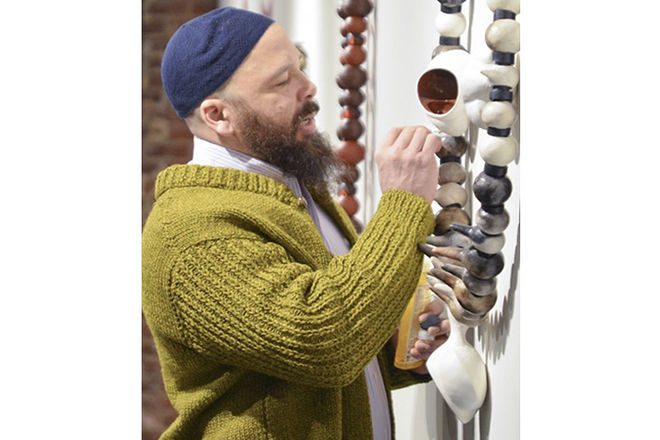
Sharif Bey was raised in a large African American family in Pittsburgh. While many of the men in his family left school for jobs in industry, Bey had a pivotal experience at the Manchester Craftsmen’s Guild while attending high school. Shortly after the fall of the Soviet Union, he studied sculpture at the Academy of Fine Arts and Design in Bratislava, Slovakia. Later, Bey earned his BFA from Slippery Rock University, his MFA from the University of North Carolina, and his PhD in art education from Pennsylvania State University.
Bey’s sculptures reference the visual heritage of Africa and Oceania, as well as present-day African American culture, exploring the significance of traditional beads and figurines through contemporary reinterpretations of these forms. He works primarily with ceramics, a medium historically used by communities to create both functional objects and objects of worship.
Works by Sharif Bey can be found in public collections across the United States including the Museum of Fine Arts, Houston; the Smithsonian American Art Museum, Washington D.C; the Carnegie Museum of Art, Pittsburgh; the Columbus Museum of Art, Columbus; and the Everson Museum of Art, Syracuse. Recent institutional solo presentations include Sharif Bey: Excavations, Carnegie Museum of Art, Pittsburgh, PA (2021); Sharif Bey: Colonial Ruptures, Gardiner Museum, Toronto, CA (2022); Sharif Bey: Facets, Everson Museum of Art, Syracuse, NY (2022); and Sharif Bey: Ancestral Vestiges, Belger Arts Center, Kansas City, MO (2023).
Bey has served as a resident artist at the McColl Center for Art + Innovation, the John Michael Kohler Arts Center, the Pittsburgh Glass Center, and the Archie Bray Foundation for the Ceramic Arts. His awards include a United States Artists grant, New York Foundation for the Arts Artist Fellowship, Pollock-Krasner grant, and J. William Fulbright scholarship. Currently, Bey is an associate professor of art at Syracuse University.
Lubaina Himid

Photo by Magda Stawarska.
Lubaina Himid (b. 1954, Zanzibar) lives and works in Preston, UK, and is emeritus professor of contemporary art at the University of Central Lancashire. She is the winner of the 2017 Turner Prize and the 2024 Suzanne Deal Booth | Flag Art Foundation Prize.
Himid has exhibited extensively in the UK and abroad. Significant solo exhibitions include: So Many Dreams, Musée cantonal des Beaux-Arts, Lausanne/Platforme 10, Switzerland (2022); Water Has a Perfect Memory, Hollybush Gardens, London (2022); Lubaina Himid, Tate Modern, London (2021); Spotlights, Tate Britain, London (2019); The Grab Test, Frans Hals Museum, Haarlem, The Netherlands (2019); Lubaina Himid, CAPC Bordeaux, France (2019); Work From Underneath, New Museum, New York (2019); Gifts to Kings, MRAC Languedoc Roussillon Midi-Pyrénées, Sérignan (2018); Our Kisses are Petals, BALTIC Centre for Contemporary Art, Gateshead (2018); The Truth Is Never Watertight, Badischer Kunstverein, Karlsruhe (2017); Navigation Charts, Spike Island, Bristol (2017); and Invisible Strategies, Modern Art Oxford (2017).
Selected group exhibitions include: Rewinding Internationalism, Scenes from the ‘90s, Van Abbemuseum, Eindhoven, Netherlands; When We See Us, Zeitz Museum of Contemporary Art Africa, Cape Town, South Africa; In the Heart of Another Country, Deichtorhallen, Hamburg, Germany; Globalisto, Musée d’art moderne et contemporain de Saint-Étienne Métropole, Saint-Priest-en-Jarez, France; Human Conditions of Clay, John Hansard Gallery, Southampton (all 2022); Happy Mechanics, Hollybush Gardens, London; Life Between Islands: Caribbean-British Art 50s-Now, Tate Britain, London; Lubaina Himid –Lost Threads, The British Textile Biennial, The Great Barn, Gawthorpe Hall, Padiham, Burmley; Mixing It Up: Painting Today, Hayward Gallery, London; Relations: Diaspora and Painting, Esker Foundation, Calgary, Canada; Invisible Narratives 2, Yamamoto Keiko Rochaix, London; Unsettled Objects, Sharjah Art Foundation, Sharjah (all 2021); Frieze Sculpture, London; Risquons-Tout, WIELS, Contemporary Art Centre, Brussels; Slow Painting, Hayward Touring UK travelling exhibition (all 2020); En Plein Air, The High Line, New York (2019–2020); Sharjah Biennial 14, UAE (2019); Glasgow International (2018); Berlin Biennale (2018); The Place is Here, Nottingham Contemporary, UK (2017); Keywords, Tate Liverpool (2014); and Burning Down the House, Gwangju Biennale (2014).
Her work is held in various museum and public collections, including Tate; British Council Collection; Arts Council Collection; UK Government Art Collection; Museum Ludwig, Cologne; Victoria & Albert Museum, London; National Museums Liverpool; Whitworth Art Gallery, Manchester; Hammer Museum, Los Angeles; and Rhode Island School of Design, Providence.
Bronwyn Katz

Photo by Haneem Christians.
Incorporating sculpture, installation, video, and performance, Bronwyn Katz’s practice engages with the concept of land as a repository of memory and trauma, reflecting on the notion of place or space as lived experience, and the ability of the land to remember and communicate the memory of its occupation.
Working with found natural materials such as iron ore, or used manmade objects such as foam mattress and bed springs, Katz’s approach to making is driven by storytelling and intuition. Conceptually, her sculptures refer to the political context of their making, embodying subtle acts of resistance that draw attention to the social constructions and boundaries that continue to define our environments.
For Katz, the language of abstraction is in active opposition to overt representation, allowing her work to be open to multivalent readings. Hers is a minimalism that converses with early forms of abstract art; methods and traditions of mark-making and story-telling that long predate Western Modernism.
Katz has held six solo exhibitions to date, including I turn myself into a star and visit my loved ones in the sky at White Cube in London (2021), Salvaged Letter at Peres Projects in Berlin (2019), / // ! ǂ at blank projectsin Cape Town (2019), and A Silent Line, Lives Here at the Palais de Tokyo in Paris (2018).
Recently, her work has been included in the 59th International Art Exhibition of the Venice Biennale, the 2021 New Museum Triennial of New York and the Future Generation Art Prize shortlist exhibition. Previous group exhibitions include Upkeep: Everyday Strategies of Care (The Arts Club of Chicago, 2020); We Aim to Live(Zuzeum Art Centre, Riga, 2020); NIRIN (Biennale of Sydney, 2020); and Là où les eaux se mêlent (Biennale de Lyon, 2019). In 2019, she was awarded the First National Bank Art Prize.
Katz is a founding member of iQhiya, an eleven-woman artist collective which has performed across various spaces, including Documenta (in Kassel and Athens), Greatmore Studios, and Iziko South African National Gallery.
Born in 1993, in Kimberley, South Africa, Katz lives and works between Cape Town and Johannesburg.
Kapwani Kiwanga
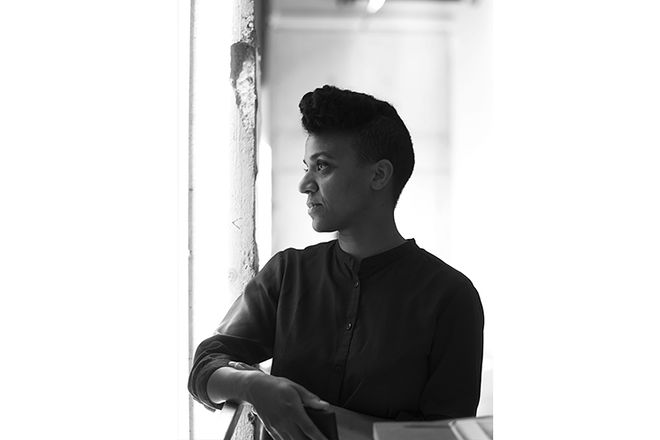
Portrait of Kapwani Kiwanga, 2016 ©Bertille Chéret
Kapwani Kiwanga (b. Hamilton, Canada) lives and works in Paris. Kiwanga studied anthropology and comparative religion at McGill University in Montreal and Art at l’école des Beaux-Arts de Paris.
In 2020, Kiwanga received the Prix Marcel Duchamp. She was also the winner of the Frieze Artist Award and the annual Sobey Art Award in 2018.
Solo exhibitions include Hausder Kunst, Munich; Kunstinstituut Melly–Center for Contemporary Art, Rotterdam; Kunsthaus Pasquart, Biel / Bienne; MIT List Visual Arts Center, Cambridge; Albertinummuseum, Dresden; Artpace, San Antonio; Esker Foundation, Calgary; Tramway, Glasgow International; Power Plant, Toronto; Logan Center for the Arts, Chicago; South London Gallery, London; and Jeu de Paume, Paris; among others.
Selected group exhibitions include Whitechapel Gallery, London; Serpentine Galleries, London; Yuz Museum, Shanghai; MOT–Museum of Contemporary Art Tokyo; Museum MMK für Moderne Kunst, Frankfurt; Museum of African Contemporary Art Al Maaden–MACAAL, Marrakech; National Gallery of Canada, Ottawa; Contemporary Arts Museum, Houston; Hammer Museum, Los Angeles; Centre Pompidou, Paris; Musée d’art contemporain de Montréal; ARoS Aarhus Art Museum, Aarhus; and MACBA, Barcelona.
She is represented by Galerie Poggi, Paris; Goodman Gallery, Johannesburg, Cape Town, and London; galerie Tanja Wagner, Berlin.
Kapwani Kiwanga is a Franco-Canadian artist based in Paris. Her work traces the pervasive impact of power asymmetries by placing historic narratives in dialogue with contemporary realities, the archive, and tomorrow’s possibilities.
Her work is research driven, instigated by marginalized or forgotten histories, and articulated across a range of materials and mediums including sculpture, installation, photography, video, and performance.
Kiwanga co-opts the canon; she turns systems of power back on themselves, in art and in parsing broader histories. In this manner she has developed an aesthetic vocabulary that she describes as “exit strategies,” works that invite one to see things from multiple perspectives so as to look differently at existing structures and find ways to navigate the future differently.
Abigail Lucien

Photo by Grace Roselli.
Abigail Lucien (b. 1992) is a Haitian American interdisciplinary artist. Working in sculpture, literature, and time-based media, Lucien’s practice addresses themes of (be)longing, futurity, myth, and place by considering our relationship to inherited colonial structures and systems of belief/care. Lucien was named to the 2021 Forbes 30 Under 30 list, is a recipient of a 2021 Virginia Museum of Fine Arts Fellowship, and was the 2020 Harpo Emerging Artist Fellow. Past exhibitions include Sculpture Center and MoMA PS1 in New York, MAC Panamá (Panamá), Tiwani Contemporary (London), Atlanta Contemporary (Atlanta, Georgia), and the Fabric Workshop and Museum (Philadelphia). Residencies include Amant Studio and Research Residency in New York, the Eugeniusz Geppert Academy of Fine Arts (Wrocław, Poland), the Luminary (St. Louis), Santa Fe Art Institute (New Mexico), ACRE (Wisconsin), and Ox-Bow School of Art and Artist Residency (Michigan). Lucien is currently based in Baltimore, Maryland, where they teach sculpture at the Maryland Institute College of Art.
Tsedaye Makonnen

Photo by Adeyemi Michael.
Tsedaye Makonnen is an artist-curator, mother, and birth worker of East African descent. Her studio practice primarily focuses on intersectional feminism, reproductive health and migration. Her intention is to create a spiritual network around the world that re-calibrates the energy towards something positive and life affirming.
In 2019 Tsedaye was a Smithsonian Artist Research Fellow and staged two interventions at the Venice Biennale titled When Drowning is the Best Option feat. Astral Sea I. In 2021 her light sculptures were acquired by the Smithsonian for their permanent collection, and she published a book titled Black Women as/and the Living Archive with WPA. Tsedaye is the recipient of a permanent large-scale public art commission for Providence, R.I. In Fall 2022 she performed at the Venice Biennale for Simone Leigh’s Loophole of Retreat and was the inaugural Clark Art Institute’s Futures Fellow and a Franklin Furnace Fund award recipient. This 2023, Tsedaye will be exhibiting at The Metropolitan Museum of Art, Bard Graduate Center and The Walters Art Museum; as well as performing with Wanda Raimundi-Ortiz and Ayana Evans at Crystals Bridges Museum and The Momentary. She is currently represented by Addis Fine Art. She lives between DC and London with her partner and children.
Additionally, Makonnen has performed at Art Basel Miami, Art on the Vine (Martha’s Vineyard), Chale Wote Street Art Festival (Ghana), El Museo del Barrio, Fendika Cultural Center (Ethiopia), Festival International d’Art Performance (Martinique), Queens Museum, the Smithsonian’s & more. Her work has been featured in Artsy, NY Times, Vogue, BOMB, Hyperallergic and more. Other exhibitions include Artspace New Haven, Mattress Factory, Photoville, NYU Tisch, Walters Art Museum, Washington Project for the Arts, CFHill gallery, National Gallery of Art, UNTITLED Art Fair, 1:54 Contemporary African Art Fair, Park Avenue Armory, National Museum of Women in the Arts, The Momentary, Art Dubai & more.
Otobong Nkanga

Photo by Wim van Dongen.
Otobong Nkanga’s work foregrounds ecological themes of relationality and becoming through a distilled poetics of entanglement. Her multidisciplinary practice examines the complex social, political, and material relationships between bodies, territories, minerals, and the earth. Unsettling the divisions between minimal and conceptual or sensual and surreal approaches, the artist’s research-based practice constellates humans and landscapes, organic and non-organic matter, and Global North and Global South economies. Through drawing, installation, performance, photography, textiles, and sculpture, Nkanga creates pathways translating the natural world—its plants, herbs, minerals and living organisms—into networked, aggregated situations evoking memory, labor, home, care, ownership, emotion, touch, and smell.
Otobong Nkanga (born 1974, Kano, Nigeria) lives and works in Antwerp, Belgium. She studied at the Obafemi Awolowo University in Ife-Ife, Nigeria and the École Nationale Supérieure des Beaux-Arts in Paris, and she holds a master’s degree in the performing arts from DasArts, Advanced Research in Theatre and Dance studies in Amsterdam. Nkanga was an artist-in-residence at the Rijksakademie van beeldende kunsten in Amsterdam (2002–04), DAAD Berlin (2013–14), and the Martin Gropius-Bau (2019).
Her most recent solo exhibitions include Sint-Janshospitaal, Bruges, Belgium (2022); Kunsthaus Bregenz, Austria (2021); Castello di Rivoli Museum of Contemporary Art, Turin, Italy (2021–22); Villa Arson, Nice, France (2021); Henie Onstad Kunstsenter, Høvikodden, Norway (2020–21); Gropius Bau, Berlin, Germany (2020); MIMA, Middlesbrough, UK (2020); Tate St Ives, UK (2019); Zeitz Museum of Contemporary Art Africa, Cape Town, South Africa (2019); Ar/ge kunst Galleria Museo, Bolzano, Italy (2018); Museum of Contemporary Art Chicago (2018); Kunsthal Aarhus, Denmark (2017); Nottingham Contemporary, UK (2016); Beirut Art Center, Lebanon (2016); Tate Modern, London (2015); Museum Folkwang, Essen, Germany (2015); Stedelijk Museum Schiedam, Schiedam, the Netherlands (2015); Portikus, Frankfurt, Germany (2015), Museum of Contemporary Art Antwerp, Belgium (2015); Kadist Art Foundation, Paris (2015).
Her participation in international group shows includes: Busan Biennial 2022—We, on the Rising Wave, Museum of Contemporary Art, Busan, South Korea (2022); KUB in Venice, Scuola di San Pasquale, Venice, Italy (2022); Black Melancholia, Hessel Museum of Art, New York (2022); Currency: Photography Beyond Capture, 8th Triennial of Photography Hamburg, Hamburg, Germany (2022); We Are History, Somerset House, London, UK (2021); Witch Hunt, Hammer Museum, Los Angeles (2021); Global(e) Resistance, Centre Pompidou, Paris, France (2020); Our World is Burning, Palais de Tokyo, Paris, France (2020); Seismic Movements, Dhaka Art Summit, Bangladesh (2020); 58th International Art Exhibition - La Biennale di Venezia, Venice, Italy (2019); Sharjah Biennial 14: Leaving the Echo Chamber, Sharjah, UAE (2019); Artes Mundi 2018’ National Museum Cardiff, UK (2018); Cosmogonies, according to the elements, MAMAC, Nice, France (2018); General Rehearsal, Moscow Museum of Modern Art, Russia (2018); Documenta 14, Athens, Greece and Kassel, Germany (2017); I am a native foreigner, Stedelijk Museum, Amsterdam, the Netherlands (2017); Take Me (I’m Yours), Pirelli Hangarbicocca, Milan, Italy (2017); Dialogues, Manifesta—The European Biennial of Contemporary Art, Amsterdam, the Netherlands (2017); Life Itself, Moderna Museet, Stockholm, Sweden (2016); Museum on/off, Centre Pompidou, Paris, France (2016); 13th Biennale de Lyon, La vie moderne, Lyon,France (2015); Africa Remix, Johannesburg Art Gallery, Johannesburg, South Africa, Mori Art Museum,Tokyo, Japan, Moderna Museet, Stockholm, Sweden, Centre Pompidou, Paris, France, Hayward Gallery, London, UK, and Museum Kunstplast, Düsseldorf, Germany (2004–07).
Nkanga was given the Special Mention Award at the 58th International Art Exhibition of La Biennale di Venezia, Italy (2019) and won the 2017 Belgium Art Prize. Other notable awards include the Peter-Weiss-Preis, Sharjah Biennial Prize, the Lise Wilhelmsen Art Award, the Flemish Cultural Award for Visual Arts—Ultima, and the Yanghyun Prize.
Zohra Opoku

Zohra Opoku, Portrait of the Artist, 2022. Photographed by Danny Wonders. Courtesy of Mariane Ibrahim
Zohra Opoku (b.1976, German and Ghanaian; lives and works in Accra, Ghana) examines the politics of personal identity formation through historical, cultural, and socio-economic influences, particularly in the context of contemporary Ghana.
Opoku’s explorations have been mostly through the lens of her camera; her photography is expressed through screenprinting and alternative photo processing on varieties of natural fabrics. While her work relays social commentary and broadly relevant themes around the human experience, Zohra’s explorations are intimately rooted in personal identity politics. She repeatedly integrates family heirlooms and her self-image into her visual observations of Ghana’s cultural memory.
Her work is in the collections of renowned institutions such as the Cleveland Clinic Collection, Faurschou Foundation, Royal Museum of Ontario, Samuel P. Harn Museum of Art, CCS Bard College Hessel Museum of Art, Los Angeles County Museum of Art, and the Tate Modern.
Julia Phillips

“Headshot”, 2018, Julia Phillips & Keisha Scarville
Julia Phillips (b. 1985) was born in Hamburg and lives and works in Chicago and Berlin. She has had one-person exhibitions at MoMA PS1 in New York and the Kunstverein Braunschweig in Germany, and was featured in the Berlin Biennial and the New Museum Triennial. Her work has been shown at museums including the Museum of Contemporary Art in Chicago, the Museum of Fine Arts in Boston, the Museu de Arte de São Paulo, and the Studio Museum in Harlem. Phillips was included in the 59th Venice Biennale’s central exhibition, The Milk of Dreams, curated by Cecilia Alemani. Her High Line commission, Observer, Observed, is on view through August 2023.
Nari Ward

Photo by World Red Eye. Courtesy of Pérez Art Museum Miami.
Nari Ward (b. 1963, St. Andrew, Jamaica; lives and works in New York) is known for his sculptural installations composed of discarded material found and collected throughout his neighborhood. He has repurposed objects such as baby strollers, shopping carts, bottles, doors, television sets, cash registers, and shoelaces, among other materials. Ward recontextualizes these found objects in thought-provoking juxtapositions that create complex, metaphorical meanings to confront social and political realities surrounding race, migration, democracy, and community, intentionally leaving the meaning of his work open to allow his viewers to provide their own interpretations.
Perennial themes of memorial, remembrance, and societal relationships have permeated Ward’s practice, from his early, now-iconic installation Amazing Grace (1993), composed of discarded fire hoses and hundreds of abandoned strollers, to the work he is creating today. Amazing Grace was produced during Ward’s residency at The Studio Museum in Harlem in response to the AIDS crisis and drug epidemic of the early 1990s. It incorporated more than 365 discarded baby strollers—commonly used by the homeless population in Harlem to transport their belongings—which the artist bound with twisted fire hoses in an abandoned fire station in Harlem. Echoing through the space was a recording of gospel singer Mahalia Jackson’s “Amazing Grace,” with lyrics addressing themes of redemption and change and generating a sense of hope and optimism. In his most recent work, Ward engages ideas of commemoration, community, and the reclamation of public space through the medium of public streets. His new, large-scale copper Peace Walk panels are patterned after sidewalk squares and show the imprints of floral bouquets, spent candles, empty liquor bottles, and other objects that Ward collected from various street memorials near his studio. The series title comes from protest terminology, referring to people coming together to walk or march against an injustice. Here and throughout his practice, Ward identifies public streets as belonging to local communities—while these spaces have functioned as sites of grief and consolation, the artist also nods to their longstanding role as a stage for protest.
Nari Ward received a BA from City University of New York, Hunter College, in 1989, and an MFA from City University of New York, Brooklyn College, in 1992. Select solo exhibitions of his work have been organized at Fondazione Nicola Trussardi, Milan, Italy (2022); Vilcek Foundation, New York, NY (2022); Museum of Contemporary Art, Denver, CO (2020); Contemporary Arts Museum Houston, Houston, TX (2019); New Museum, New York, NY (2019); Institute of Contemporary Art, Boston, MA (2017); Socrates Sculpture Park, New York, NY (2017); The Barnes Foundation, Philadelphia, PA (2016); Pérez Art Museum Miami, Miami, FL (2015); Savannah College of Art and Design Museum of Art, Savannah, GA (2015); Louisiana State University Museum of Art, Baton Rouge, LA (2014); The Fabric Workshop and Museum, Philadelphia, PA (2011); Massachusetts Museum of Contemporary Art, North Adams, MA (2011); Isabella Stewart Gardner Museum, Boston, MA (2002); and Walker Art Center, Minneapolis, MN (2001, 2000). Select group exhibitions featuring his work include Sharjah Biennial 15, Sharjah Art Foundation, Sharjah, United Arab Emirates (forthcoming); In the Heart of Another Country, Deichtorhallen, Hamburg, Germany (2022); Prospect.5 New Orleans: Yesterday we said tomorrow, New Orleans, LA (2021); Grief and Grievance, New Museum, New York, NY (2021); The Dirty South: Contemporary Art, Material Culture, and the Sonic Impulse, Virginia Museum of Fine Arts, Richmond, VA (2021) and Crystal Bridges Museum of American Art, Bentonville, AR (2022); Promise, Witness, Remembrance, Speed Art Museum, Louisville, KY (2021); NGV Triennial, National Gallery of Victoria, Melbourne, Australia (2020); Objects Like Us, The Aldrich Contemporary Art Museum, Ridgefield, CT (2018-2019); UPTOWN: nastywomen/badhombres, El Museo del Barrio, New York, NY (2017); Black: Color, Material, Concept, The Studio Museum in Harlem, New York, NY (2015); The Great Mother, Fondazione Nicola Trussardi, Palazzo Reale, Milan (2015); The Freedom Principle: Experiments in Art and Music, 1965 to Now, Museum of Contemporary Art Chicago, Chicago, IL (2015); NYC 1993: Experimental Jet Set, Trash and No Star, New Museum, New York, NY (2013); Contemplating the Void: Interventions in the Guggenheim Rotunda, Solomon R. Guggenheim Museum, New York, NY (2010); Whitney Biennial, New York, NY (2006); Landings, Documenta XI, Kassel, Germany (2002); Passages: Contemporary Art in Transition, The Studio Museum in Harlem, New York, NY (1999); Projects: How to Build and Maintain the Virgin Fertility of Our Soul, MoMA PS1, Long Island City, NY (1997); Whitney Biennial, New York, NY (1995); and Cardinal Points of the Arts, 45th Venice Biennale, Venice, Italy (1993).
Ward’s work is in numerous international public and private collections, including the Albright-Knox Art Gallery, Buffalo, NY; Akron Art Museum, Akron, OH; Baltimore Museum of Art, Baltimore, MD; Blanton Museum of Art, Austin, TX; Brooklyn Museum, New York, NY; Columbus Museum of Art, Columbus, OH; Crystal Bridges Museum of American Art, Bentonville, AR; Dallas Museum of Art, Dallas, TX; Denver Art Museum, Denver, CO; DESTE Foundation for Contemporary Art, Athens, Greece; GAM, Galleria Civica di arte, Torino, Italy; Institute of Contemporary Art, Boston, MA; Istanbul Modern, Istanbul, Turkey; Long Museum, Shanghai, China; Museum of Contemporary Art, Los Angeles, CA; Musée d’Art Moderne Grand-Duc Jean, Luxembourg; Museum of Modern Art, New York, NY; Nasher Museum of Art at Duke University, Durham, NC; National Gallery of Victoria, Southbank, Australia; New York Historical Society, New York, NY; New York Public Library, New York, NY; Pérez Art Museum Miami, FL; Princeton University Art Museum, Princeton, NJ; Sharjah Art Foundation, Sharjah, United Arab Emirates; Smithsonian American Art Museum, Washington, D.C.; Speed Art Museum, Louisville, KY; Studio Museum in Harlem, New York, NY; Virginia Museum of Fine Arts, Richmond, VA; Walker Art Center, Minneapolis, MN; and the Whitney Museum of American Art, New York, NY, among numerous others. Ward has received numerous honors and distinctions including the Fellowship Award, The United States Artists, Chicago (2020); Vilcek Prize in Fine Arts, Vilcek Foundation, New York (2017); the Joyce Award, The Joyce Foundation, Chicago (2015), the Rome Prize, American Academy of Rome (2012), and awards from the American Academy of Arts and Letters (1998), the Pollock- Krasner Foundation (1996); and the National Endowment for the Arts (1994). Ward has also received commissions from the United Nations and the World Health Organization.
Amanda WIlliams

Amanda Williams (b. Evanston, 1974) is a visual artist and architect (Bachelor of Architecture from Cornell University). Her practice employs color as an operative means for drawing attention to the complex ways race informs how we assign value to the spaces we occupy. Williams’ installations, sculptures, paintings, and works on paper seek to inspire new ways of looking at the familiar and in the process, raise questions about the state of urban space and ownership in America.
Williams’s exhibitions include the Museum of Modern Art in New York (2021), the Venice Architecture Biennale (2018), the Museum of Contemporary Art Chicago (2020), and at the Pulitzer Arts Foundation in St. Louis, a public commission with Andres L. Hernandez (2017). She is co-designer of a forthcoming permanent monument to Shirley Chisholm in Prospect Park in Brooklyn, NY. She is on the Museum Design Team for the Obama Presidential Library Center.
Williams is a MacArthur Fellow, an Architectural Record awardee, a USA Ford Fellow, a Joan Mitchell Painting and Sculpture grantee, a 3Arts Next Level awardee, and is the inaugural Artist-In-Residence at Smith College. She is highly sought after as a lecturer, including a 2018 Ted Talk. Amanda sits on the boards of several organizations including the Black Reconstruction Collective, the Pulitzer Arts Foundation, and the Graham Foundation.
Her work is in several permanent collections including the Art Institute of Chicago and the Museum of Modern Art (New York). In a recent participatory artwork titled Embodied Sensations, Williams considers how COVID-19 has reshaped how we move and how we relate to one another. She examines the stark inequities and systemic injustices that underlie such shifts, asking us to reflect on control and freedom, isolation and community, prejudice and violence, love and fear. Her projects have been published in Black Futures (One World, 2020) and Radical Architecture of the Future (Phaidon Press, 2021). She lives and works on the south side of Chicago.











